If you’re an antique glass collector and you’re not yet aware of the concept of vaseline glass, then you’re certainly missing out! Vaseline glass continues to be one of the most unique and intriguing types of antique glass that attracts collectors from all across the globe. Their highlighted feature is typically their unusual designs and unparalleled appeal to individuals with or without the knowledge of antique glass.
Vaseline glass is primarily known for its incredible color schemes, rich history, and the radioactive material used in its production. Unlike other popular types of glass, vaseline glass consists of various chemical components that make the glass translucent and greatly enhance its visual appeal. This type of glass comes in various different shapes and patterns, each having some level of historical and monetary value.
If you plan on joining the vaseline glass collectors community, then you’ll be glad to know that you’re in the right place because we’ve got just what you need! Before doing so, you need to be fully aware of the different aspects of vaseline glass pieces. This is essential in identifying vaseline pieces by recognizing their age, manufacturer, pattern, and country of origin. Properly identifying a particular piece of vaseline glass, you can also get an accurate idea of the value of that piece in today’s market. This will prove to be highly beneficial every time you decide to buy or sell vaseline glass pieces.
For your convenience, we’ve compiled everything you need to know about vaseline glass right here in this guide. So without further ado, let’s get straight into the topic!
Table of Contents
What Is Uranium Glass?
Uranium glass, otherwise known as vaseline glass is a special type of antique glass that is popularly known for its yellowish green color that gives it the appearance of vaseline petroleum jelly. Uranium glass gets its name from Uranium Dioxide which is an essential component of the glass mixture. This Uranium Dioxide is also responsible for the signature yellow glass color that uranium glass is known to possess and what makes it so different from other types of antique glass.
Uranium glass can further be divided into three sub-types primarily depending on the color and attributes of the glass.
Vaseline Glass
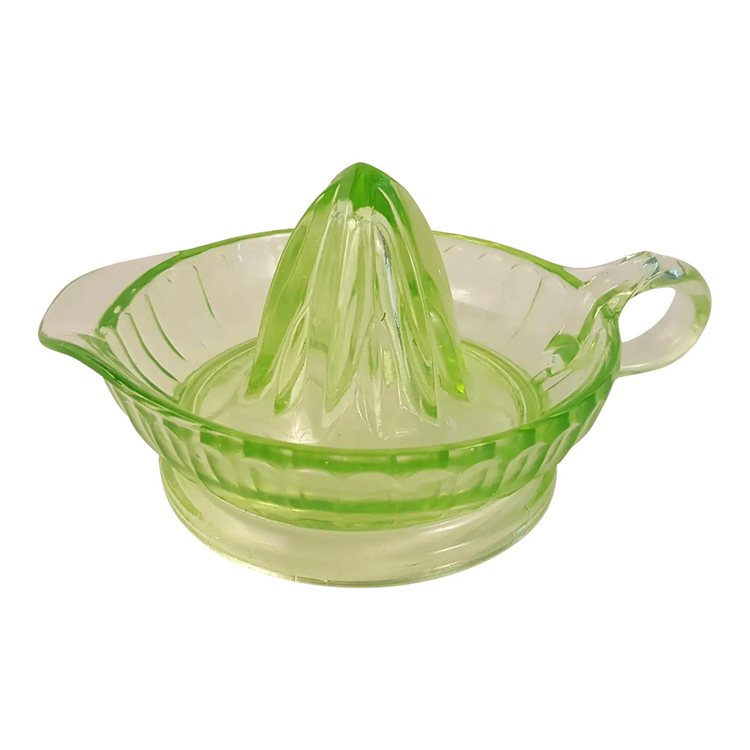
Vaseline glass is arguably the most popular and precious type of uranium glass that is known for its unique yellow-green glass color. Vaseline glass glows green when shined by black light, which is one of the many reasons why antique collectors of the modern era find interest in collecting this type of glass.
Custard Glass
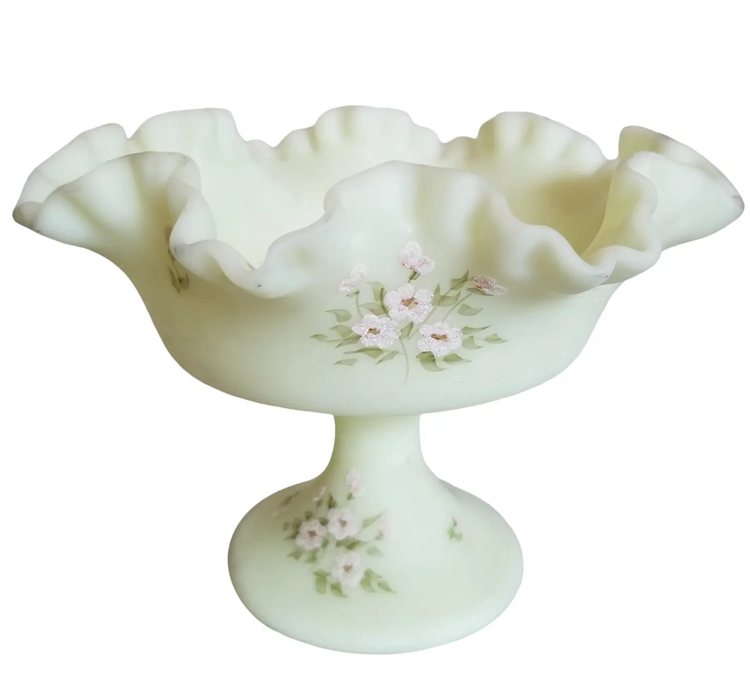
Custard glass is a semi-opaque or opaque pale yellow form of uranium glass that is readily available in today’s market. Custard glass isn’t as valuable as vaseline glass; however, it’d still be a great addition to your antique glass collection. Collectors generally use the “fire test” to identify a piece of this type of glass. The glass adopts a reddish opalescence sheen appearance when held up against the light, which can be an effective way to distinguish it from vaseline glass.
Jadite Glass
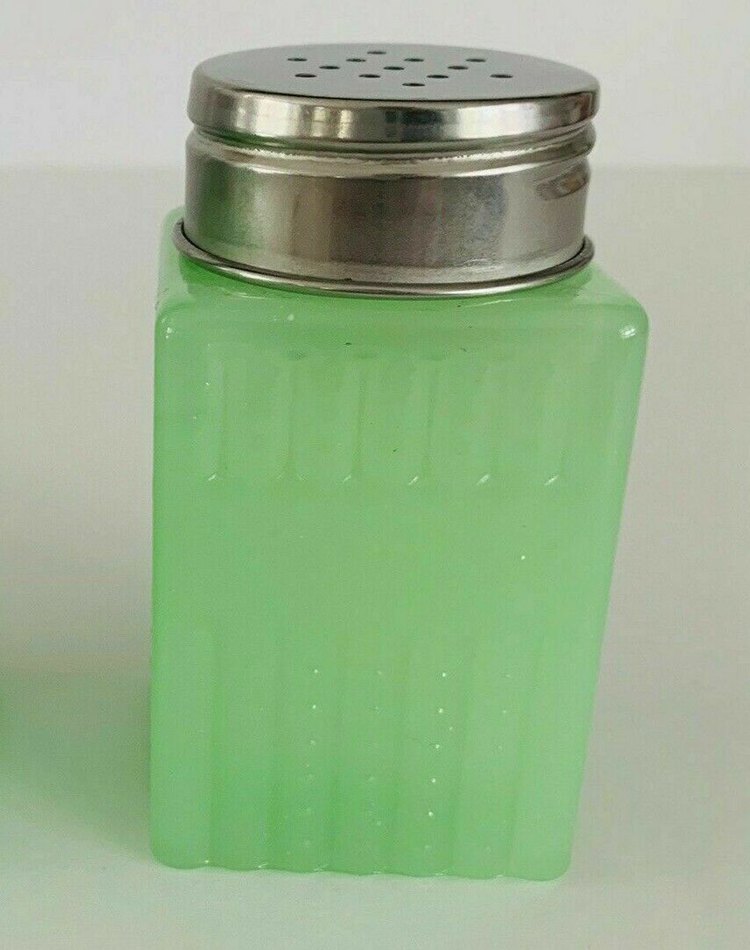
This type of uranium glass has a semi-opaque or opaque pale green color and appears quite similar to custard glass. Once again, this type of uranium glass is generally cheaper than vaseline glass and can be easily accessible from retail stores or antique shops.
History Of Uranium Glass
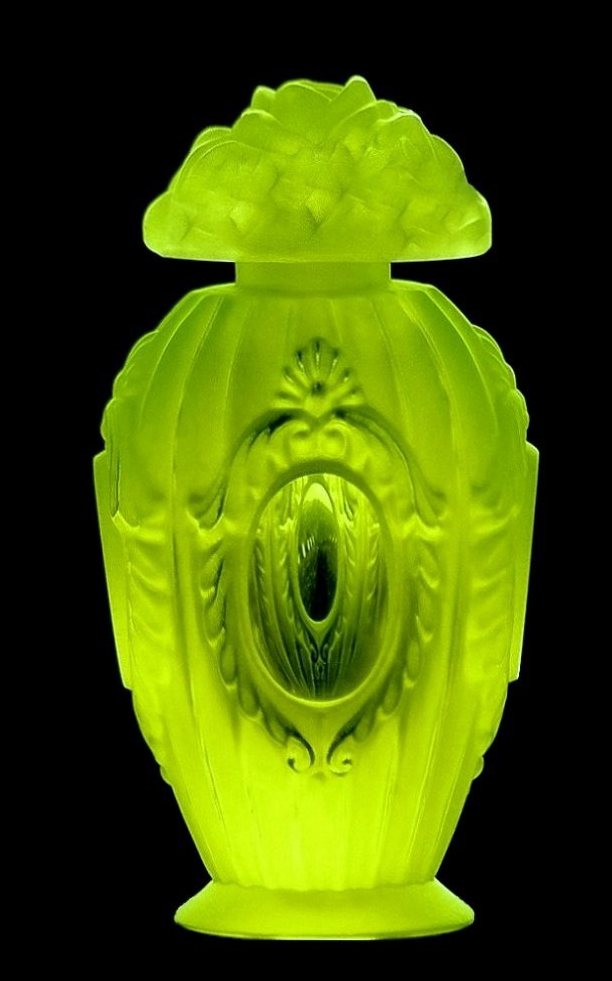
Similar to various other types of antique glassware, vaseline and uranium glass have a quite rich history, which every collector needs to be fully aware of in order to be an integral part of the uranium glass enthusiasts community. For centuries, uranium glass has been used for the purpose of production of uranium glassware. However, it wasn’t until the 1830s that this became a renowned trend all across the glass production industry. The popularity of vaseline glass grew gradually and it peaked during the 1880s when the glass was being distributed globally for decoration purposes.
Over the years, various popular glass companies became involved in the production and distribution of vaseline glass, the most popular of which were Steuben Glass, Adams & Company, Baccarat, and Cambridge Glass Company. Other manufacturers were also known to contribute numerous unique and intriguing designs and patterns to the industry. Initially, vaseline glass was primarily produced in yellow color; however, makes eventually began to add iron oxide in the glass mix, which is responsible for giving uranium glass the yellow-green tint that it is known for.
The production of uranium glass was restricted after the 1920s following the devastating effects of the use of uranium in World War II. By 1970, nearly all US glass manufacturers had officially ceased the production of radioactive glass; however, production was still continued by certain glass manufacturers overseas.
In the modern era, vaseline glass once again begins to grow in popularity because of its unparalleled beauty and immense visual appeal among collectors and glassware traders. Various antique glass collectors considered vaseline glass to be one of the most unique and incredible types of glassware primarily because of its uranium content.
Difference Between Vaseline Glass And Depression Glass
Depression glass is another renowned type of antique glass, which is often referred to using the term vaseline glass by collectors and traders. A probable reason for this confusion between the two types of glass is that they both grew in popularity during similar time periods and various glass companies that manufacture vaseline glass also manufactured depression glass during the same time. Similar to vaseline glass, depression glass is also known to be translucent with a green and yellow tint to it. On the contrary, depression glass comes in a variety of different color schemes, including red, pink, white, black, and more. Only depression glass with yellowish green color is normally confused with uranium glass.
Safety Precautions For Vaseline Glass Collectors
Because of the uranium content in vaseline glass, various beginner collectors have a reason to doubt the safety of collecting this glass and keeping it inside their homes. It’s essential to understand that if used and handled properly, there’s nothing to worry about as uranium glass cannot hurt you in any way.
To further enhance your knowledge about vaseline glass and how you need to be handling it in your home, here are some facts that would help clear your doubts.
Vaseline Glass Is Radioactive
You must already be aware of the fact that there is a certain level of radiation in vaseline glass, primarily because of the uranium used in its production. In fact, this has been scientifically proven by the Environmental Protection Agency (EPA), which considers vaseline glass to be one of the few types of antique glass with radiation.
It is also essential to note that the level of radiation in vaseline glass is very low relative to other dangerous sources of radiation. This means that you won’t have to experience any health risks as a vaseline glass collector if you learn to store and handle the glass properly.
Vaseline Glass Is Safer Than Most Household Electronics
If you’re still concerned about being exposed to radiation from uranium glass, then you need to understand that most household items that you use in your everyday lives are likely to emit much more radiation relative to the trace levels of radioactivity found in vaseline glass. The amount of radiation that this glass emits is much lower than the amount considered to be the least harmful to individuals. In fact, the bright green fluorescence that you notice from these glass pieces isn’t a result of their radiation instead, is because the electrons in the glass become excited and emit photons when met with ultraviolet light.
This idea has further been reinforced by a systematic radiological assessment by the nuclear regulatory commission in a 2021 report that analyzed the amount of radiation present in typical households.
Do Not Eat Or Drink From Vaseline Glass
Since vaseline glass is radioactive; therefore, there are certain precautions that you need to take to avoid the slight possibility of having any sort of health risks from vaseline glass. While radiation levels are fairly low in uranium glass; however, EPA suggests collectors avoid eating or drinking anything from utensils made of vaseline glass. This is to avoid swallowing tiny fragments or chips of vaseline glass, which can prove to be harmful to your health.
Identification Guide For Vaseline Glass
As an antique vaseline glass collector, you need to be fully aware of how you can identify a piece of uranium glass to understand its authenticity. Furthermore, properly identifying can also give you an accurate idea of how valuable a particular piece is to collectors in today’s market. Since you’re a beginner in the field of vaseline glass, you are likely to experience some difficulty while trying to identify new uranium glassware. To avoid the discomfort, you are suggested to have a professional take a look and identify the piece for you; however, if you feel like giving it a shot yourself, then we’ve got you covered!
Here are some tips that can prove to be extremely beneficial in the identification of vaseline glass for beginners.
Examine The Glow
The most prominent feature of vaseline glass is the bright green glow that it gives off when placed under uv light. This feature can also be used to identify a piece of vaseline glass since other popular types of antique glass aren’t known to have such an attribute. To check for this glow, you simply need to place the glass under black light; if you don’t notice a glow, then the piece might probably be a fake.
Color Of The Glass
As discussed earlier, the color of uranium glass ranges from pale greenish-yellow to bright yellow. Properly analyzing and identifying the color of a particular piece of glassware will help you acknowledge the type of uranium glass that you’re dealing with. Additionally, if the glass has a different color that you’re unable to recognize, then you could identify it as a fake or a modern remake of the original.
Texture Of The Glass
Another important factor that is essential in identifying a piece of uranium glass is its texture. Vaseline glass is known to have a particularly oily texture that is used to distinguish it from other types of antique glassware. The translucent and oily appearance is a result of the iron oxide and uranium dioxide that is used in its production. Therefore, you need to pay close attention to the texture of the glass if you want to identify it without any inconvenience.
Shape Of Uranium Glass
Over the years, uranium glass has been popularly used for the manufacture of a number of different tools and items, including bottles, figurines, vases, mugs, chandeliers, pitchers, and more. Each type of uranium glass is known to have a unique shape and design that reinforces its purpose.
By carefully observing the shape of a specific glassware piece, you can acknowledge the intended purpose of the glassware and hence, acquire further details regarding the piece. By researching the glass shape, you can get an idea of its expected manufacturer, the era that it belongs to, and its intended purpose. This will also help you ensure the authenticity of the glass piece and avoid losing your money on fakes and modern remakes.
Date Of Manufacture
Various antique uranium glassware pieces have the date of manufacture of the piece stamped on them. The manufacture of vaseline glass was at its peak from 1800 to the 1880s; therefore, if you come across a piece is a stamped date that falls in this time period, then it is likely to be an original antique instead of being a fake or a remake.
Generally, pieces with older manufacturing dates are considered to be more antique and thus, are valued higher in the market than newer models. Therefore, knowing the manufacturing date of a piece can give you an idea of its value in the market by viewing other products from the specified time period.
Antique Vaseline Glass Value Guide
If you’ve taken interest in collecting antique vaseline glass, then it’s essential for you to have an understanding of the values and prices of the glass in today’s market. Vaseline glass typically ranges from $30 to $70 and can be found easily from online retailers or from antique stores. The exact value of a glass piece may vary depending on a number of different factors, which every collector needs to be fully aware of. Here are some of the most important factors that are responsible for determining the price of an antique uranium glass piece.
- Condition – The condition of the glassware piece is likely to have a major impact on its value in the market. If the piece is known to have chips as a result of poor maintenance, then it is likely to be cheaper than the expected value of the piece.
- Age –More antique pieces are likely to have a greater worth than newer models. Most vaseline glass pieces have a manufacturing date imprinted on them, which allows collectors to determine their exact age instantly.
- Rarity – How rare a piece is can be determined by understanding how easy or difficult it is to acquire the piece for collectors and traders. Rarity proves to be a primary factor in determining the worth of vaseline glass since incredibly rare pieces can go as high as several thousand dollars in the market.
For a better understanding, here are some pieces of antique vaseline glass sold on eBay.
- This Antique EAPG Bryce Brothers Vaseline Glass Pedestal Spooner Rose In Snow Pattern sold for $39.93
- This Scarce Antique Vaseline Swirl Canary Glass Bobeche Yellow sold for $65.00
- This CANDLESTICK LAMP Antique Uranium Glass Vaseline Depression 11 1/2″ Retro 1930s sold for $73.00
Moreover, here are some of the rarest pieces of antique vaseline glass currently available in today’s market.
Antique Chinese Peking Uranium Glass
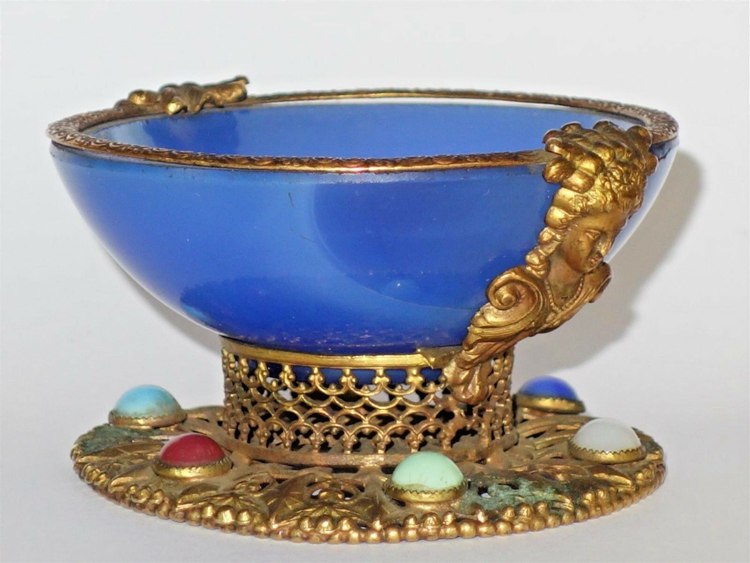
This beautiful Chinese Opium Ball dates back to the early 19th century and proves to be one of the rarest pieces of antique vaseline glass today. The glass piece originates from China while it also has some roots in France. Its greenish blue color combined with the bronze decorations at the bottom makes this piece worthwhile with its incredible appeal and unparalleled beauty. The piece is currently up for grabs for $10,000 on eBay.
1700s Colonial America Uranium Flint Glass Vase
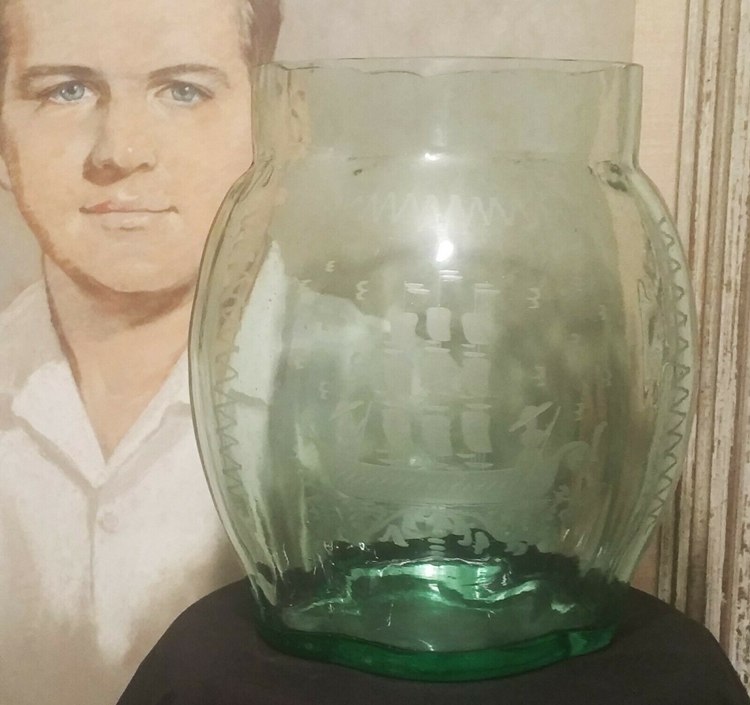
This vintage glass vase dates back to some time between 1729 and 1785 and is considered to be one of the best works of Henry William Stiegel, a renowned German-American glassmaker. The glass vase is nearly 8.5 inches tall and has a ground rim with no pontil marks. The pale green color of the glass greatly adds to its overall aesthetics and value for collectors. The piece is listed on eBay for a whopping price of $4,500.
Uranium Murano Glass Bull
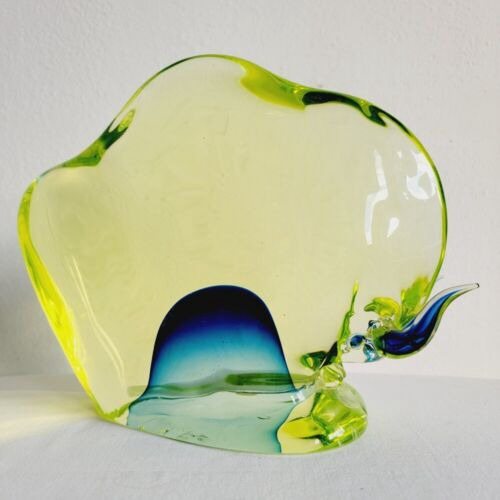
This mid-century Uranium Murano Bull piece originates from Italy and was originally manufactured by the Cenedese brand. The piece dates back to the 1970s and is popular among collectors because of its unique shape and incredible visual appeal. The piece has been sold on eBay for $2,990.
Final Thoughts
Antique glass collectors from all over the globe identify vaseline glass from its signature greenish yellow appearance that makes the glass distinct from any other type of antique glass. The glass color is insufficient to properly identify a piece of uranium glass, be sure to analyze other aspects of the piece, including its texture, markings, shape, and patterns to make the identification process much more convenient for you. Additionally, you may have a professional or experienced collector take a look and identify the piece accurately for you.
Now that you know everything there is to know, what are you waiting for? Get your first piece of vaseline glass and begin your collection right away! As you spend time observing different vaseline glass pieces in the market, your knowledge regarding the type of glass will also increase.
With that said, if you have any questions left unanswered, be sure to let us know in the comment section below.





![Where To Sell Antique Furniture In 2022 [Ultimate Guide]](https://www.jacquelinestallone.com/wp-content/uploads/2022/09/Etsy-Your-Place-To-Buy-And-Sell-All-Things-Handmade-600x450.jpg)


